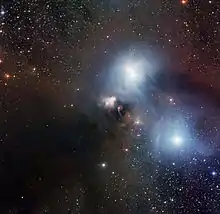R Coronae Australis
R Coronae Australis (R CrA) is a variable binary system in the constellation Corona Australis.[2][8] It has varied between magnitudes 10 and 14.36.[9] A small reflection/emission nebula NGC 6729 extends from the star towards SE. It is also the brightest feature of the Coronet Cluster, therefore sometimes called R CrA Cluster.
| Observation data Epoch J2000.0 Equinox J2000.0 | |
|---|---|
| Constellation | Corona Australis |
| Right ascension | 19h 01m 53.6503s[1] |
| Declination | −36° 57′ 07.87″[1] |
| Apparent magnitude (V) | +11.91 |
| Characteristics | |
| Spectral type | B5IIIpe[2] |
| Variable type | INSA[3] |
| Astrometry | |
| Radial velocity (Rv) | −36.0±4.9[4] km/s |
| Proper motion (μ) | RA: 1.582[5] mas/yr Dec.: −30.835[5] mas/yr |
| Parallax (π) | 10.5361 ± 0.6971 mas[5] |
| Distance | 152.9+8.1 −7.3[6] pc |
| Absolute magnitude (MV) | −0.30[7] |
| Orbit | |
| Period (P) | 45±2[8] yr |
| Semi-major axis (a) | 0.1968±0.0045[8]" (27-28 AU[6]) |
| Eccentricity (e) | 0.4[6] |
| Inclination (i) | 70[6]° |
| Details | |
| A | |
| Mass | 3.5[7] M☉ |
| Radius | 6.2[7] R☉ |
| Luminosity | 132[7] L☉ |
| Temperature | 9,550[7] K |
| Age | 1+1 −0.5[6] Myr |
| B | |
| Mass | 0.3 - 0.55[6] M☉ |
| Surface gravity (log g) | 3.45±0.06[6] cgs |
| Temperature | 3,650 - 3,870[6] K |
| Other designations | |
| Database references | |
| SIMBAD | data |

This star is moving toward the Solar System with a radial velocity of 36 km s−1. It was previously believed that in roughly 222,000 years, this system could have approached within 1.77 light-years (0.54 parsecs) of the Sun. However, the estimate had a considerable margin of error in it.[10] With the release of Gaia DR2, the star was determined to be 4 times further from the Sun than initially believed, constraining the approach to only 111 ± 31 light-years (34.0 ± 9.5 parsecs).[5] Examination of other objects known to be in the same star-forming region gives a distance of 152.9+8.1
−7.3 pc, suggesting an error in the Gaia parallax for R CrB itself.[6]
A companion to the star was proposed in 2019 with a mass between 0.1 and 1 Solar masses, depending on the characteristics of the stellar environment, orbiting the primary in 43–47 years.[8] The companion was later directly observed to be a red dwarf with a mass between 0.3 M☉ and 0.55 M☉.[6] It has also been proposed that the primary component is itself a close binary.[7]
References
- van Leeuwen, F. (13 August 2007). "Validation of the new Hipparcos reduction". Astronomy & Astrophysics. 474 (2): 653–664. arXiv:0708.1752. Bibcode:2007A&A...474..653V. doi:10.1051/0004-6361:20078357. S2CID 18759600.
- "R Coronae Australis". SIMBAD. Centre de données astronomiques de Strasbourg. Retrieved 29 June 2014.
- Samus, N. N.; Durlevich, O. V.; et al. (2009). "VizieR Online Data Catalog: General Catalogue of Variable Stars (Samus+ 2007-2013)". VizieR On-line Data Catalog: B/GCVS. Originally Published in: 2009yCat....102025S. 1. Bibcode:2009yCat....102025S.
- Gontcharov, G. A. (2006). "Pulkovo Compilation of Radial Velocities for 35 495 Hipparcos stars in a common system". Astronomy Letters. 32 (11): 759–771. arXiv:1606.08053. Bibcode:2006AstL...32..759G. doi:10.1134/S1063773706110065. S2CID 119231169.
- Brown, A. G. A.; et al. (Gaia collaboration) (August 2018). "Gaia Data Release 2: Summary of the contents and survey properties". Astronomy & Astrophysics. 616. A1. arXiv:1804.09365. Bibcode:2018A&A...616A...1G. doi:10.1051/0004-6361/201833051.
- Mesa, D.; et al. (2019). "Exploring the R CrA environment with SPHERE. Discovery of a new stellar companion". Astronomy and Astrophysics. 624. arXiv:1902.02536. Bibcode:2019A&A...624A...4M. doi:10.1051/0004-6361/201834682. S2CID 155675656.
- Sissa, E.; Gratton, R.; Alcalà, J. M.; Desidera, S.; Messina, S.; Mesa, D.; d'Orazi, V.; Rigliaco, E. (2019). "The origin of R CrA variability. A complex triple system hosting a disk". Astronomy and Astrophysics. 630. arXiv:1908.07256. Bibcode:2019A&A...630A.132S. doi:10.1051/0004-6361/201936101. S2CID 201103714.
- Cugno, G.; Quanz, S. P.; Launhardt, R.; Musso Barcucci, A.; Brems, S. S.; Cheetham, A.; Godoy, N.; Kennedy, G. M.; Henning, T.; Müller, A.; Olofsson, J.; Pepe, F.; Quirrenbach, A.; Reffert, S.; Rickman, E. L.; Ségransan, D. (3 April 2019). "ISPY – NaCo Imaging Survey for Planets around Young stars". Astronomy & Astrophysics. 624: A29. arXiv:1902.04092. doi:10.1051/0004-6361/201935142. S2CID 102491664.
- BSJ (14 June 2010). "R Coronae Australis". AAVSO Website. American Association of Variable Star Observers. Retrieved 29 June 2014.
- Dybczyński, P. A. (April 2006), "Simulating observable comets. III. Real stellar perturbers of the Oort cloud and their output", Astronomy and Astrophysics, 449 (3): 1233–1242, Bibcode:2006A&A...449.1233D, doi:10.1051/0004-6361:20054284